Castlevania symphony of the night где найти меч фамильяр
Обновлено: 04.07.2024
"Your word is my command." — Faerie to Alucard in Symphony of the Night
The Faerie Familiar is an eidolon resembling a winged sprite. She is one of the five familiars at Alucard's command in Castlevania: Symphony of the Night. She is obtained by acquiring the Faerie Card.
Game specific information
Castlevania: Symphony of the Night
The Sword Familiar is available once Alucard finds the Sword Card in Olrox's Quarters. This card can be accessed once he can turn into a bat and is located in the room right below the one where the Olrox battle took place. However, it is not accessible from the Olrox battle room, Alucard will have to access it from a hallway that runs a bit below that room, then break the ceiling near where the Holy Water is. In the original Japanese as well as all the DXC versions, the card is found in a slightly different location within the area, namely on a pedestal in a small dead-end hallway located below the Save Room. In the English-language PlayStation version, this room contains a common Garnet instead.
The Sword Familiar becomes the active familiar when the player activates the Sword Card in the Relics menu. When it is first activated, it says: "Have you power enough to wield me?", it will then hover around and every now and then head toward an enemy, stop for a moment, and then twirl around, exclaiming "Slash!" or "Slice!" and inflicting Cut damage on anything it touches. Because it stops before attacking, if Alucard is moving it will often lag behind him, and is not very effective at this point unless he is standing still. If Alucard leaves the current room while the Sword Familiar is preparing to attack or attacking, it will attack wherever it was in relation to him in the new room.
As an offensive familiar, it benefits greatly from the Mojo Mail: at high levels it can end up dealing far more damage than Alucard himself does with this armor equipped.
As the sword levels up, it will become more powerful and aggressive. Once reaching level 50 the Sword Familiar will disappear from the screen and can now be equipped as a weapon (explained below) or reactivated in the Relics menu to continue working as a familiar. At level 50 it also changes in appearance by gaining two smaller blades on both sides of the main blade extending from the hilt. Once reaching level 60 the sword changes in appearance one last time with the blade changing to a deep blue color that glows blue to blue-green and with the tip of the blade becoming pointed instead of rounded off. In this state, it also deals damage when moving to a new attack location, leaving a trail in the air when it does so. At level 70 it changes its method of attack, instead of its original attacking method of attempting to fly near enemies, which is usually very inaccurate, and slicing in a circle, it will now quickly fly directly at an enemy, or group of enemies, damaging them and then flying into the background, then damaging the same enemies or different enemies it targets as it quickly flies back into the foreground. In The Dracula X Chronicles port of Symphony of the Night, the sword does not turn blue at level 60, and it does not deal damage when passing through enemies.
The Sword Familiar is the only familiar which can use a spell. The Sword Brothers spell is accomplished by pressing down, then rolling the directional pad 180° forward and holding up for two seconds, and then pressing down and attack at the same time. It will perform a move that damages all enemies on the screen. This will consume a hefty 30 MP, the second highest consuming spell after Soul Steal.
Once the Sword Familiar hits level 50, there will be a short animation where it travels diagonally across the screen twice with "shing" sounds, and then disappears, automatically switching off its Relic. When this happens, it can be equipped as a normal 1-handed sword by equipping the new "Sword Familiar" weapon that has appeared in Alucard's inventory, or re-summoned as a familiar by turning the Sword Card Relic back on. When equipped, it has a +ATK boost equal to its level. The Sword Familiar won't level up when equipped, though, and the Sword Brothers spell cannot be used while it is being held. The next time the Sword Card is activated, it will say "You have grown mighty, my master. I grant you my power."
There are a series of glitches related to the Sword Brothers spell, which can allow the player to go to areas of the castle they normally cannot and increase their percentage game complete to levels higher than intended. Sword Brothers also allows the game to be paused in situations where it should not be possible to do so (most notably on the Master Librarian's store menu and during save operations) which allows for exploitation of an integer underflow error if the player has just one of a particular type of gem: by triggering Sword Brothers, going to the "sell gem" section of the Librarian's menu while it is active and pausing the game, the player can equip the gem, exit the pause menu and still sell it. Since this will result in selling 1 gem while having 0, the value will underflow to the maximum of 255, which can then be sold normally. Selling a huge number of gems will show hexadecimal values in the store menu rather than normal numbers, but works normally. The maximum amount of gold Alucard can have is 999,999: anything above this is lost.
Castlevania: Aria of Sorrow
The Alastor Familiar is essentially a watered-down version of the Sword Familiar found in Symphony of the Night. It does not talk, does not level up, cannot gain abilities, does not have a special on-call attack move and cannot be equipped. Despite this, it is still a fairly useful guardian soul, randomly attacking enemies every once in a while. The only other familiar in this game is the Imp Familiar, which can be obtained much earlier in the game, but is not nearly as good. The Alastor Familiar causes about four times more damage, consumes the same amount of MP, attacks more often and has a greater attack range.
The Alastor Familiar can also be manipulated via the Waiter Skeleton's soul, Delicious Curry, but unlike the Imp Familiar, it does not deal damage per second while standing, making it ignore enemies.
It can only be found near the very end of the game, in the Chaotic Realm. The first one is found a little bit before reaching the second Save Room.
Castlevania: Dawn of Sorrow
The Alastor Familiar in this game is very similar to the one found in Aria of Sorrow. It can be commanded to attack a particular enemy by pointing to that enemy with the stylus in this game. It also gains one level for every three Alastor souls Soma obtains, up to three. It becomes stronger each time it levels up.
Like in Aria of Sorrow, the Alastor soul can only be found late in the game, in the Pinnacle and the Abyss.
While Soma cannot equip this sword in his hand as in Symphony of the Night, he can use the soul that gives him this familiar to evolve a Final Sword into the most powerful and evolved great sword in the game, the Claimh Solais.
Castlevania Judgment
In Judgment, Summon Sword Familiar is Alucard's guard-breaking attack.
Castlevania (animated series)
In "For Love", Alucard uses his sword in a similar way to that of the familiar in Symphony of the Night.
Familiar

A Familiar ( 使い魔 , Tsukaima ? ) is an eidolon summoned by the player. Familiars can take many forms, such as bats, ghosts and imps, among many others, or they could be formed from the souls of captured enemies. Their most common purpose is to provide the player with support skills. Some familiars may also use special attacks to assist the player in combat.
Castlevania: Symphony of the Night marks the first appearance of any such summoned creature in the Castlevania series.
Contents
Sword Familiar
"Have you power enough to wield me?" — Sword to Alucard in Symphony of the NightThe Sword Familiar ( 剣魔 (インテリジェンスソード) , Interijensu Sōdo ? ) is a sword which has free will and generally attacks on its own without being wielded in its owner's hands. This is essentially an Evil Sword that helps the player instead of trying to kill them.
Description
Although the Faerie may appear not very useful at first (she seems to just hang back behind Alucard), she plays two roles which, depending on the player's particular playstyle, may be critical to their progress.
Her first role is that of a cleric. If at any time Alucard is under a status condition that he's not immune to by way of equipment, the Faerie will administer the appropriate remedy without the player having to manually equip Alucard. If Alucard is assaulted by a particular special attack, the Faerie will deploy the best resistance potion against said assault. Should Alucard's HP fall into the critical range (<=25%), she'll throw Potions to Alucard (as long as he has in stock) until his HP are back in the safe range for his level. The Faerie throws items of lowest strength first, moving up when Alucard has run out of such items. She'll usually not throw Elixirs and never use acquired food, but as she is the only being able to make use of Life Apples, she is capable of reviving Alucard and restoring him to full HP should he fall in battle. She will, however, use Elixirs in the same fashion as Life Apples if she is level 70 or higher. Her exclusive use of Hammers allows her to free a petrified Alucard much more quickly than if the player were to manually free him out of his entrapment. These behaviors increase in probability as her experience level grows.
It should be noted that a Duplicator does not work in combination with the Faerie Familiar; it only prevents a decrease in the number of items when Alucard uses them from his hands, not when the Faerie uses them.
The Faerie also has the helpful habit of flying toward, then commenting on, secret walls near Alucard's current location ("There's something funny about this wall."), among other similar actions.
The Japanese version of Symphony of the Night and the PSP version (and later versions based on it) also contain a Fairy Familiar (called a Half-Faerie Familiar in the Japanese version), which is brought out with the Fairy Card. It is identical to the Faerie familiar, except that it can sing a song. The Saturn version includes an exclusive item called the Song Lyrics Card which causes the Fairy familiar to sing more often.
In Castlevania Judgment, the Sprite Familiar is an arms accessory that can be equipped to customize the appearance of a character. She sits on the character's shoulder and can be unlocked by accumulating 10 hours of gameplay.
Contents
Castlevania: Symphony of the Night [Обзор игры]
Серия Castlevania выходит (или выходила) с 1986 года и на данный момент насчитывает более 30 игр. Но сейчас я хочу поговорить о самой лучшей игре серии, по мнению фанатов. Итак Castlevania: Symphony of the Night вышла в 1997 году и является продолжением другой игры, Castlevania: Rondo of Blood, вышедшей в 1993 на консоли PC Engine(на западе она вышла под названием Turbografx 16) только в Японии.
Предыстория и сюжет:

Обратно в 1997 год
Игра начинается с последнего уровня Rondo of Blood, где вы за Рихтера Белмонта идёте в последнюю схватку с Лордом Тьмы. Если вы проиграете бой, то появится девочка, которую зовут Мария Ренард, и сделает героя неуязвимым.

Мария, Рихтер(справа в углу) и Дракула?
После победы над Дракулой, спустя 4 года, Рихтер исчезает и на его поиски отправляется повзрослевшая Мария. Поиски приводят девушку к восставшему из ада замку Дракулы. Тем временем из долгой спячки просыпается сын кровососа, Алукард, который отправился к родовому замку, чтобы расправится с его хозяйном. На этом предысторию игры закончим и перейдём к игровому процессу.
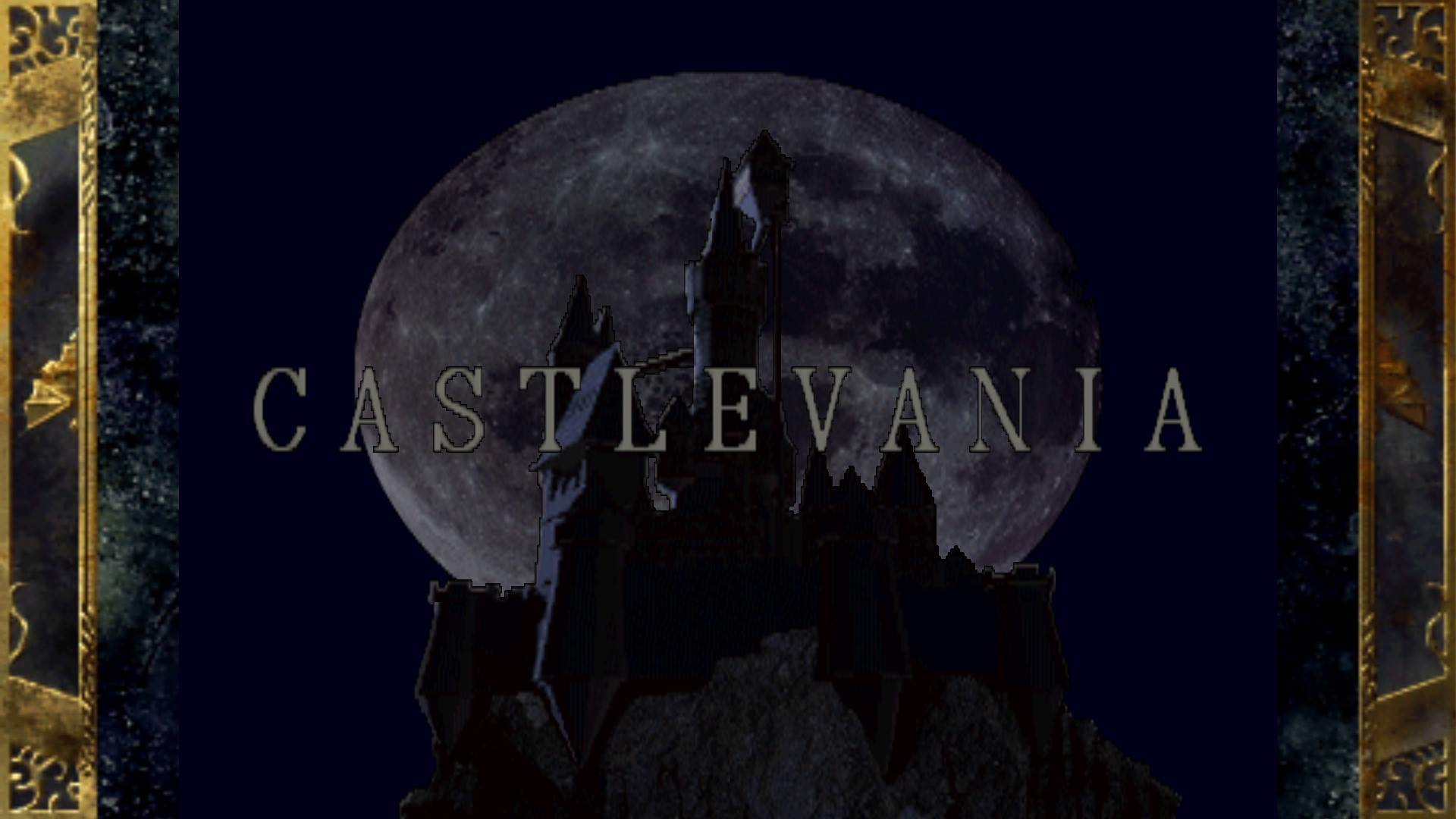
Игровой процесс:
В отличии от своего дебюта (который состоялся в игре Castlevania: Dracula's Curse), где Алукард копировал атаки своего отца из первой части cериала, сын Дракулы пользуется большим арсеналом оружия и кое-какой магией.

Кстати выбор Алукарда в качестве главного героя можно также объяснить тем фактом, что продюсер игры всегда хотел сделать игру по Dracula's Curse. Если присмотреться, то некоторые враги как и в Rondo of Blood это перерисованные спрайты из 3 части
И первое, что стоит отметить, что эта часть является платформером с элементами РПГ. У Алукарда, кроме здоровья и маны, имеются 6 характеристик: сила(STR), телосложение(CON), интеллект(INT), удача(LCK), урон(ATT), защита(DEF).
Сила и телосложение увеличивают урон и защиту соответственно, интеллект увеличивает урон от магии и спецоружия, а удача увеличивает шанс нанести критический урон и получить предмет после убийства врага.
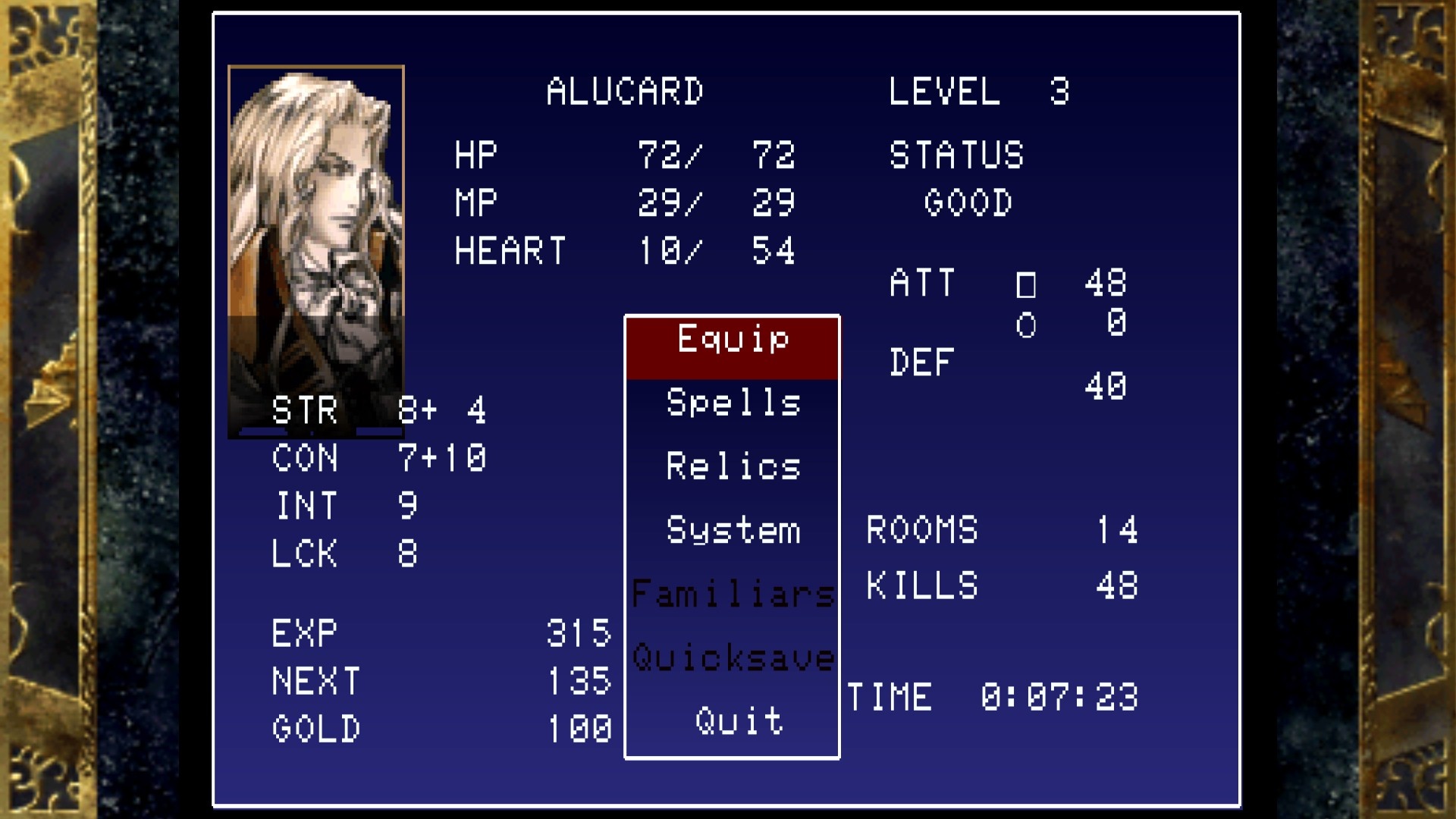
Начальные характеристики Алукарда зависят от того как быстро и насколько аккуратно Рихтер одолел Дракулу
Что же по поводу исследования замка, то вначале у нас на руках одна из самых сильных экипировок в игре, но вскоре у нас её отбирают, и мы ходим по сути голым исследовать гигантский замок.
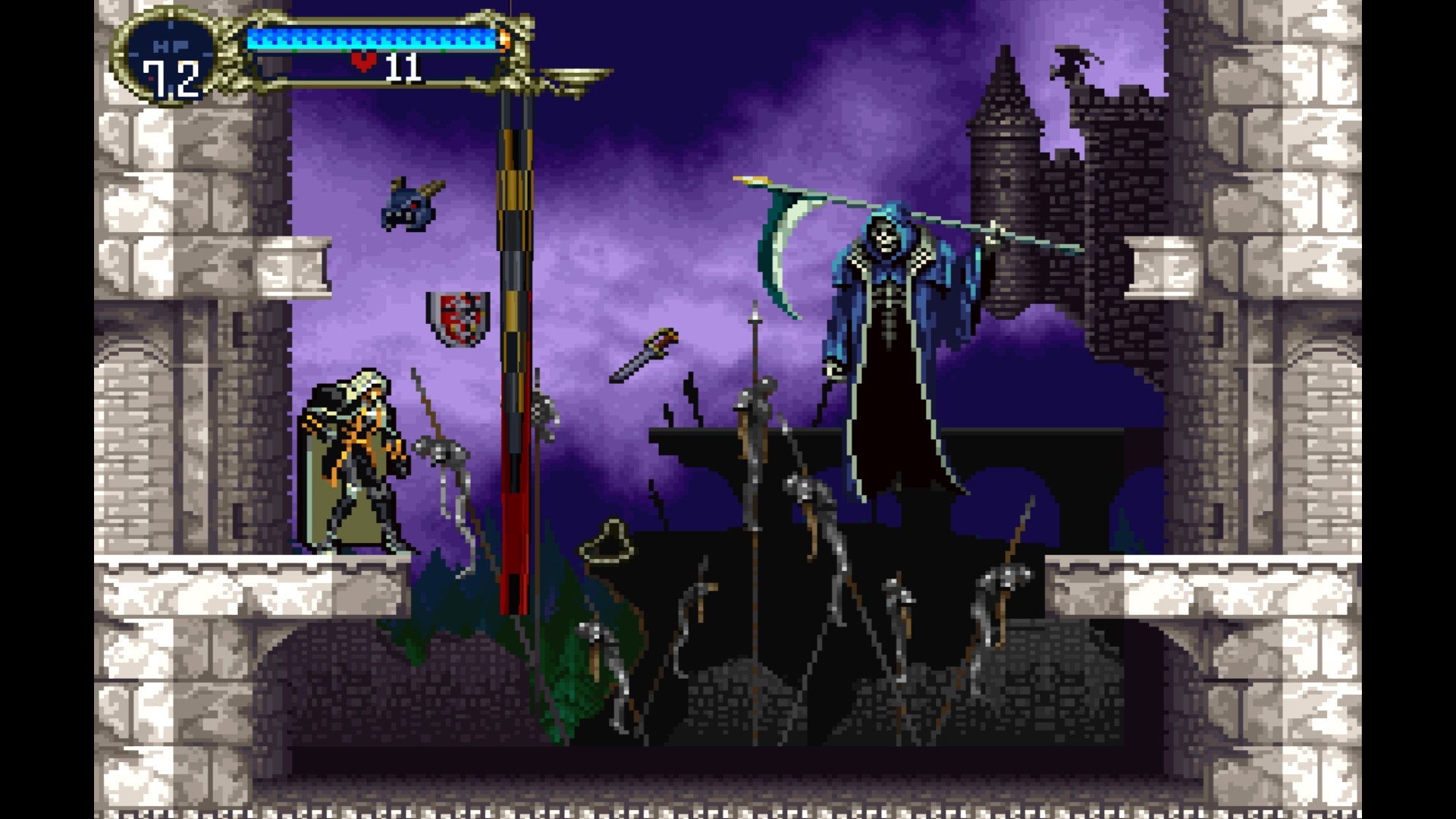
Смерть за что ты так с нами?
Сама игра в этом плане напоминает игры серии Метроид, где игрок, получая новые способности(или хорошо освоив некоторые игровые механики) открывает проход в разные локации. В Symphony мы также находим (иногда покупаем у торговца) новые вещи или способности и получаем доступ к новым местам замка.
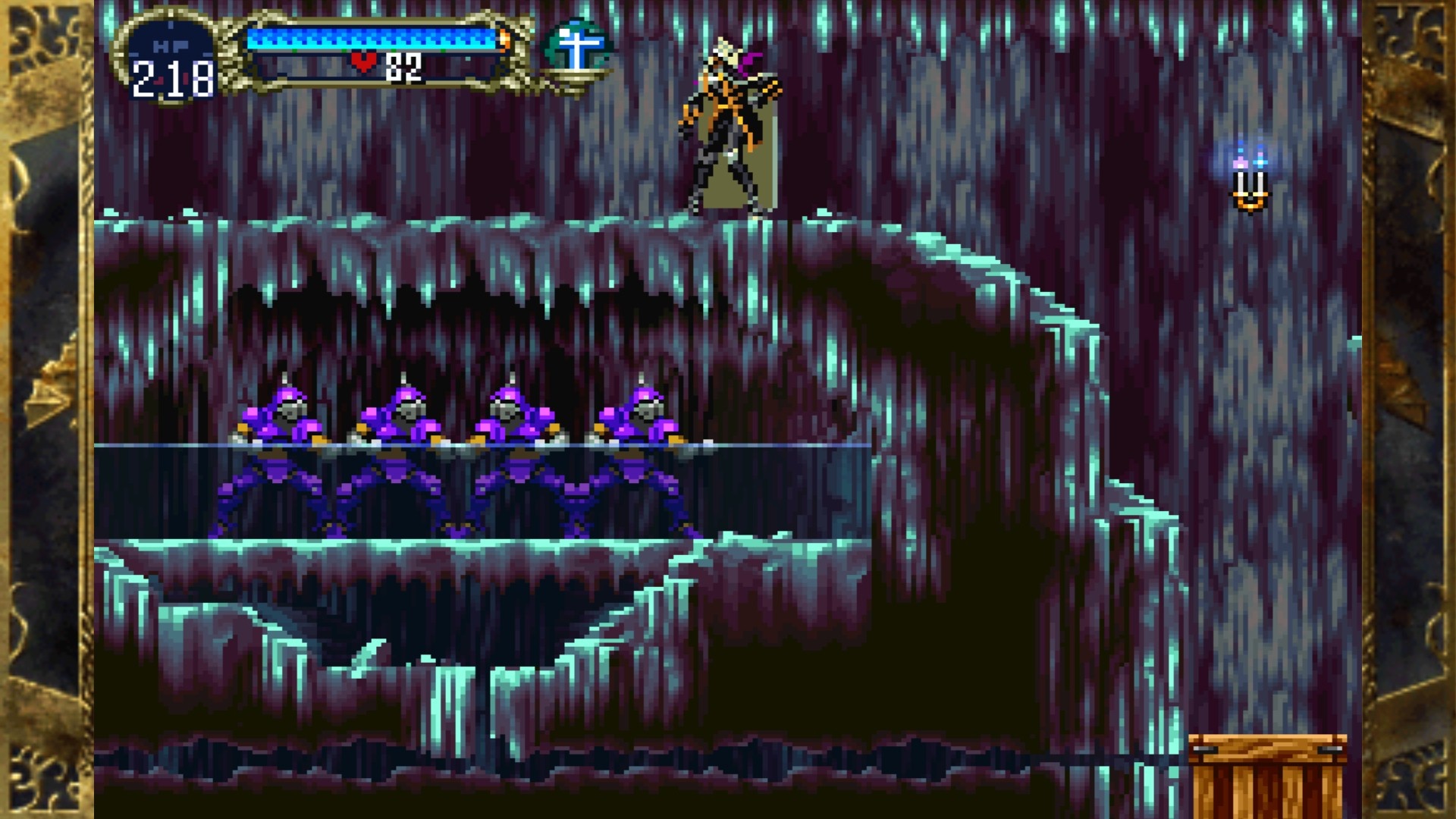
Приятно утопить врага, который стоит у тебя на пути)
И стоит упомянуть и сами локации. Замок Дракулы довольно красивое и атмосферное место. Гигантская библиотека, церковь, часовая башня из Rondo of Blood, катакомбы, алхимическая лаборатория- всё нарисовано на совесть и придачу на заднем иногда тоже что-то происходит.
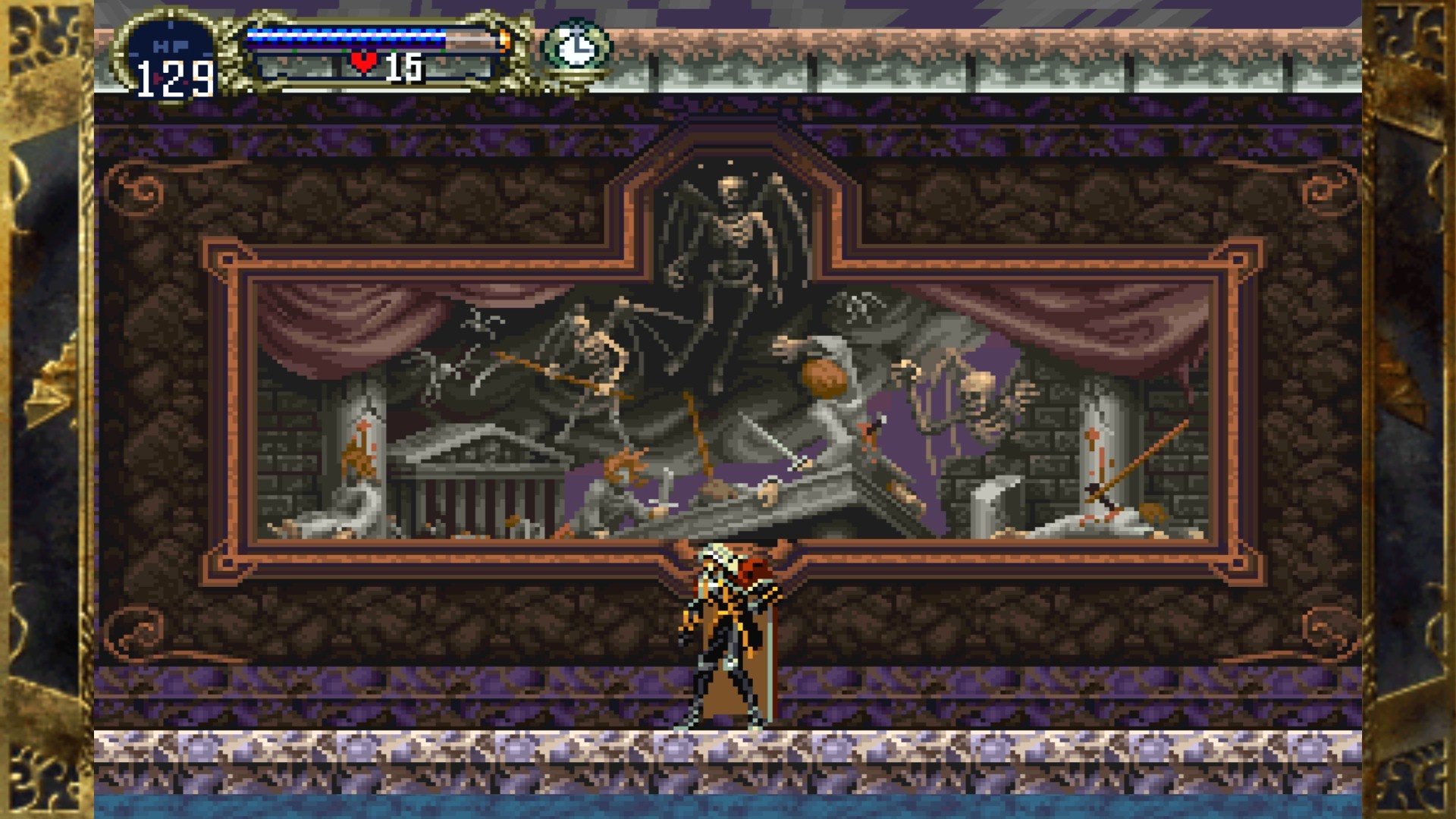
Замечательная картина!
Где-то работает фонтан, из-за решёток зомби-заключённые просят выпустить их, горят маленькие огоньки и так далее. В некоторых местах, когда вы проходите мимо, ракурс камеры на задний план тоже меняется, от чего хочется поменять маршрут и посмотреть поближе что там.

Как например в этой комнате.
Так же атмосферу придаёт и саундтрек, написанный Мичурэ Яманэ. Эта девушка до этого уже работала над музыкой для другой игры серии, но здесь её талант показан в полной мере. Все композиции довольно запоминающиеся и разнообразные. Рок, церковный хор, просто тихая расслабляющая музыка, довольно депрессивные мелодии; придачу каждая композиция подходит для своей локации или боссу.
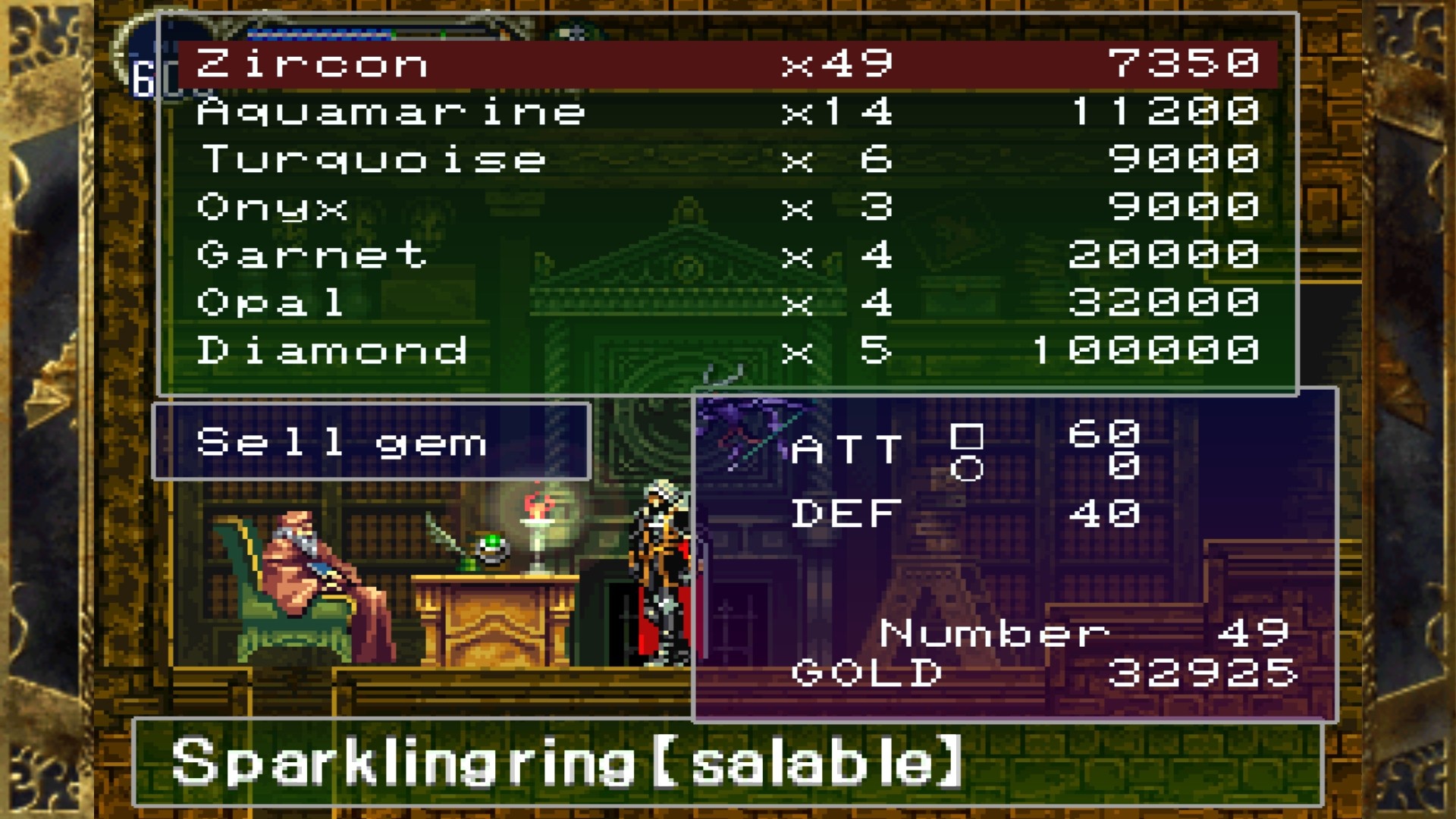
Местный торговец принимает на продажу только самоцветы, но к вашему счастью его ассортимент довольно скудный)

Погода тоже меняется иногода, но жалко, что только в этой локации)
А чем же отличается исследование от Метроида кроме введения РПГ элементов? Скажем так требованием к платформингу. Алукарду не надо точно прыгать на платформы что бы продвинуться дальше, в отличии от Самус Аран(главной героини Метроида). Игра за Самус требует от вас точно расчёта каждого прыжка, каждого действия. К тому вы должны проверять каждый миллиметр локации, так как без этого вы просто не пройдёте дальше.
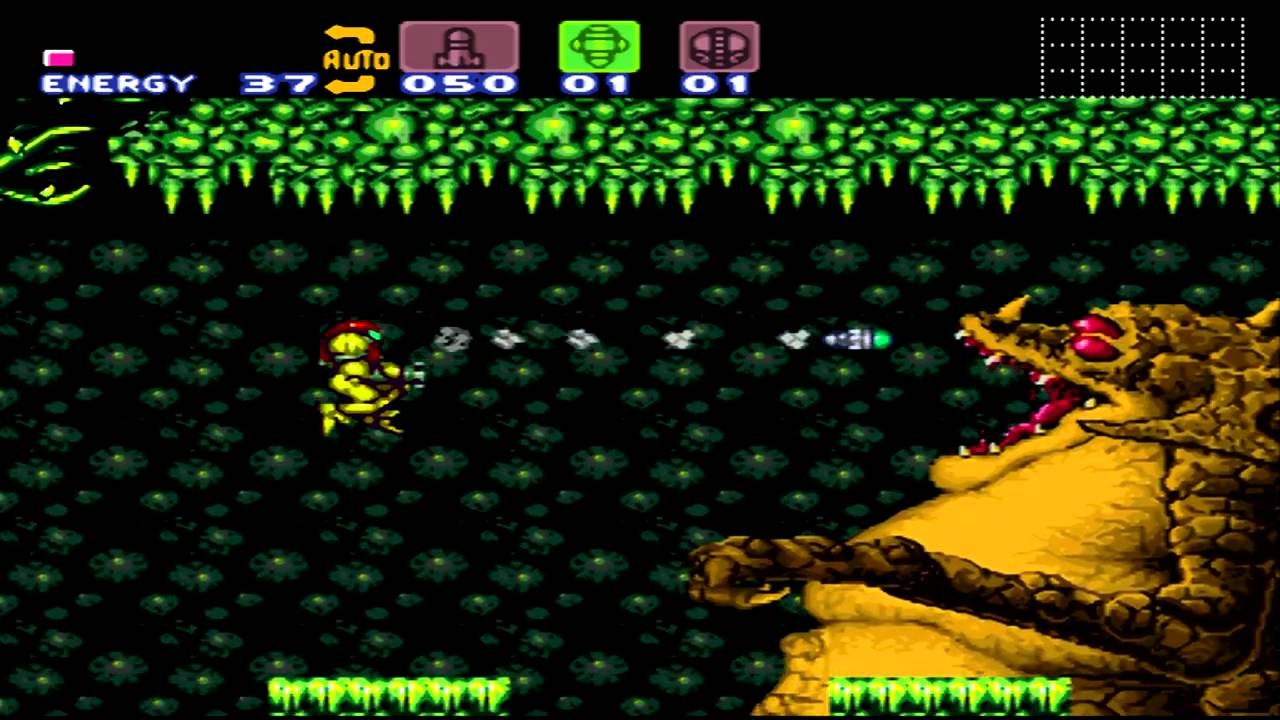
Случайный скриншот из Метроид 3(более известной как Супер Метроид).
Приведу пример. Когда я играл в Метроид 3 в первый раз я наткнулся на тупик и долго не мог понять куда идти, пока не обнаружил в стене брешь, которую можно пробить ракетой. В итоге я прошёл к боссу получил способность и пошёл дальше. И всё исследование в Метроиде работает по этой схеме. Вы заходите в тупик, используйте какую-нибудь способность Самус и идёте дальше. А чтобы собирать сами секреты, вам нужно просто идеально управлять героиней(посмотрите любое скоростное прохождение Метроида). В Castlevania таких моментов нет и локации за разрушаемыми объектами именно секреты, а не важные для прохождения моменты.
Помощники:
На своём пути Алукард может находить специальные карты, которые призывают так называемых помощников или фамильяров. Эти маленькие создание путешествуют вместе с Алукардом и помогают ему в исследовании. Среди них есть феи, черепок приведение, летучая мышь, волшебный меч и 2 чертёнка(один чертёнок эксклюзивен только для японских версий игры и Dracula X Chronicles). Эти создания тоже прокачиваются и с каждым новым уровнем помогают в битве с врагами. Некоторые из них применяются и в кое-чём другом.
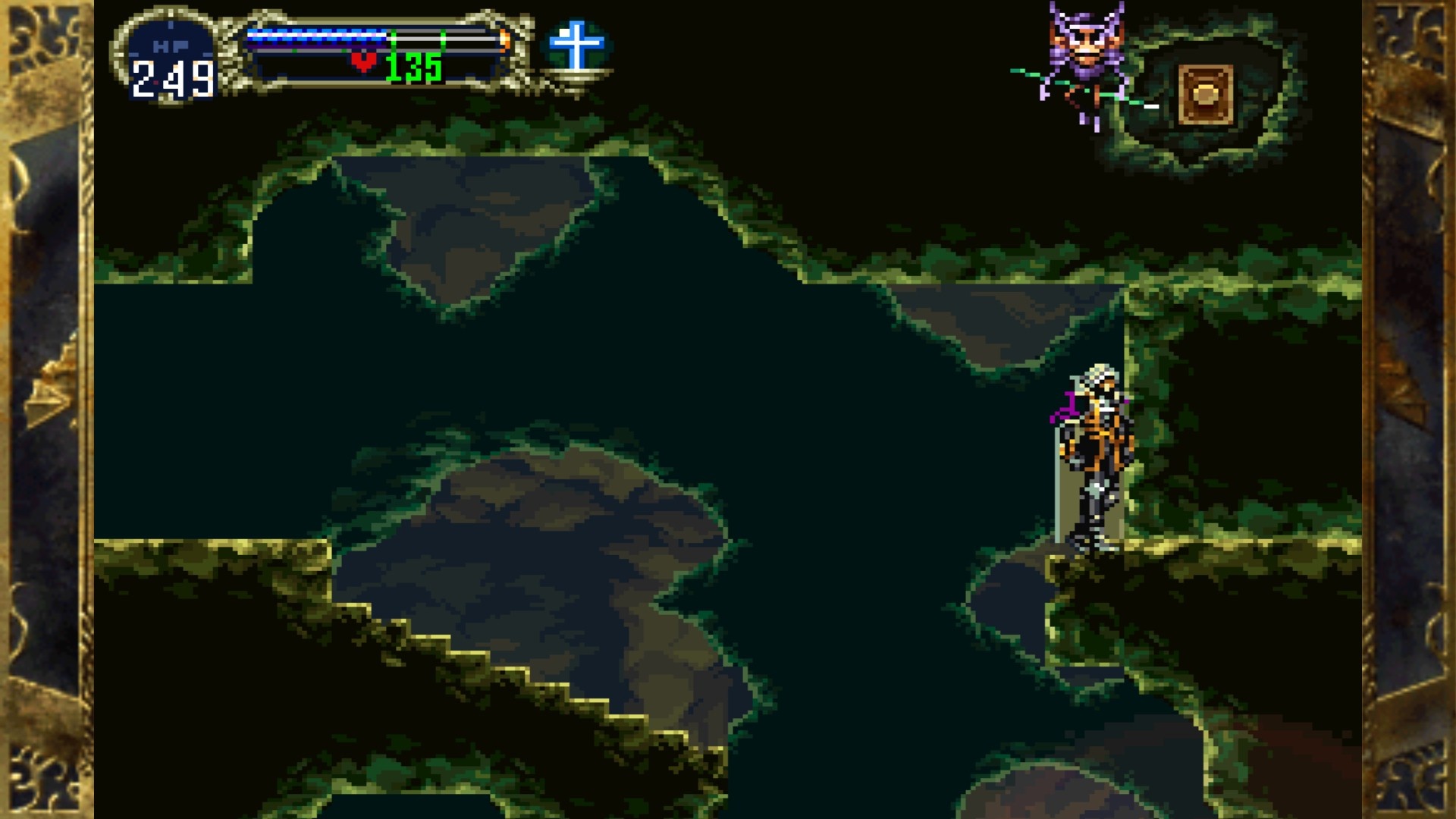
Чертята, например, открывают секретные двери!
Оружие и предметы
О разнообразии оружия можно говорить долго. Тут вам и средневековые одноручные и двуручные мечи, и катаны, и нунчаки, и топоры, и посохи, и динамит, и орудия массового поражения в виде проклятых пиктограмм. Некоторое оружие заколдовано и может призвать на вашу сторону отряд мертвецов, придать щиту магические свойства, телепортировать вас за спину вашего врага, превратить его в камень, сжечь его и заморозить. Придачу Алукард прекрасно владеет левой и правой рукой, так что вы можете спокойно экипирировать 2 оружия за раз (если оно не двуручное). Заклинания же здесь немножко отстают в плане разнообразия. Игрок может призвать злых духов, высосать души врагов, кидать фаерболлы, пить кровь раненого врага и в принципе всё.
Однако несмотря на это разнообразие кое-какое оружие лишнее, а магия тяжело используется, так как у каждого заклинания своя комбинация кнопок. Например самый бесполезный тип оружия в игре для меня это щиты. Большинство врагов сражаются в ближнем бою, из-за чего щитом вы будете пользоваться редко. Хотя в битве с парой боссов щит очень полезен.
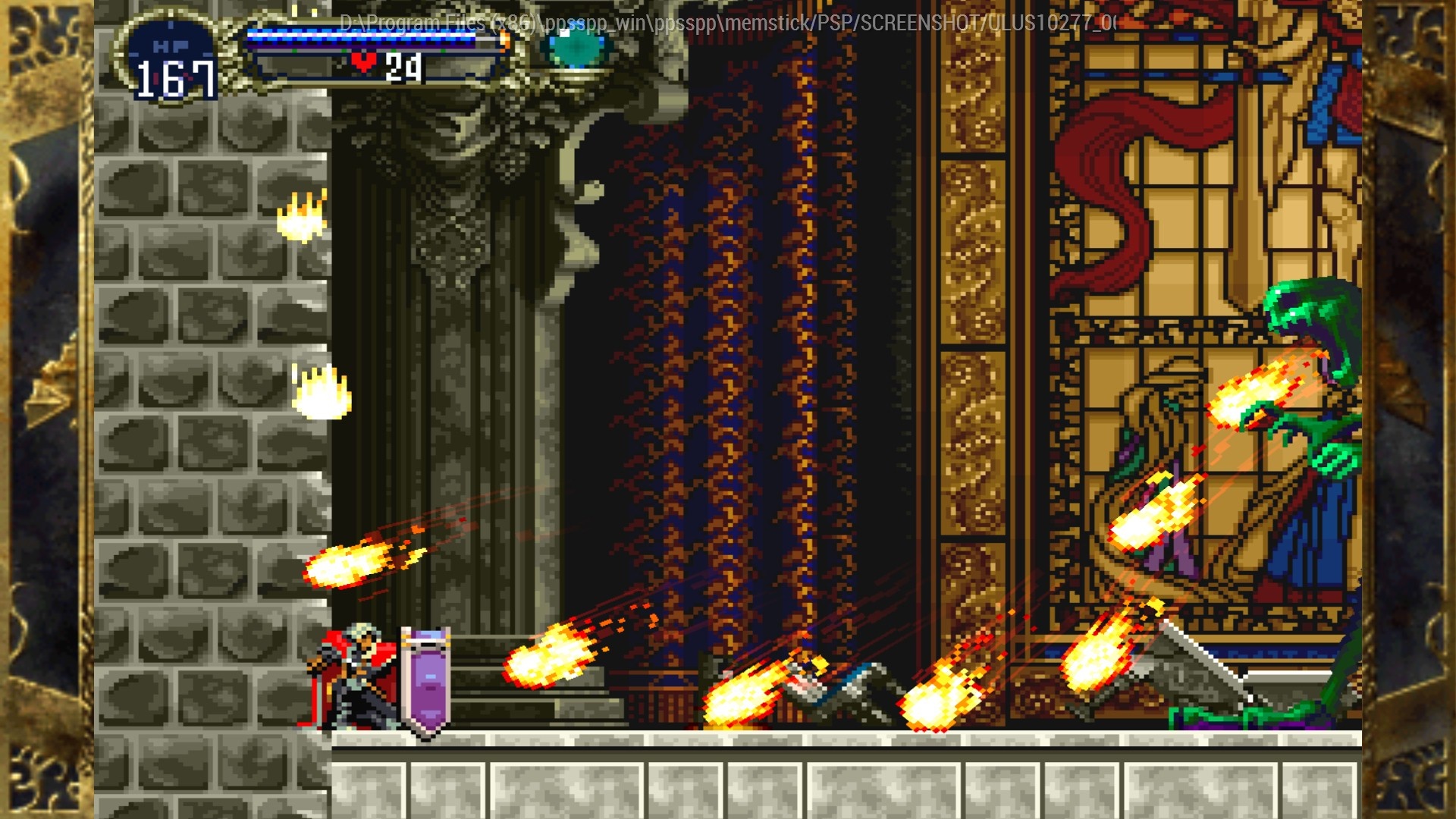
Один из боссов, где щит спасает от проблем!
Предметы в игре используются как оружие. Вы заменяете оружие в одной руке на предмет, что очень неудобно. Ну и среди всех предметов вам понадобятся только лечащие и снимающие негативные эффекты, остальные как по мне мусор.
Концовки и другие версии игры
В игре 4 концовки и последняя получается после исследования замка на 197,6%. Изначально планировалось 6 концовок(это чисто моё предположение(по крайней мере 5) и файлах игры можно найти текст 5 концовки) и в игре не хватает одной локации. Ещё тут можно играть и за Белмонта после того как пройдёте игру за Алукарда. Игровой процесс за него напоминает Super Castlevania 4, только кнутом вы управляете не так виртуозно и не можете цепляться за объекты. И так как Рихтер не умеет половины того, что умеет Алукард игра за него это чистый хардкор, так как У вас нет лечащих предметов и враги наносят вам больше урона. Ну и о других версиях игры
Sega Saturn версия:
Порт на Сатурн делался другой командой и отличается от оригинала добавлением двух новых локаций, новыми врагами, новыми композициями, добавления в качестве играбельного персонажа Марии, новыми предметами и способностями для Алукарда. Эта версия вышла только в Японии и известна своими долгими загрузками.
PSP версия (В составе игры Castlevania: Dracula X Chronicles):
В эту версию я сыграл изначально и люблю перепроходить время от времени. Была улучшена анимация, тоже в качестве играбельного персонажа добавлена Мария (но с другим геймплеем в отличии от Saturn версии) и были переозвучены все диалоги для английской версии игры. В этой версии присутствует кое-какие проблемы с картой.
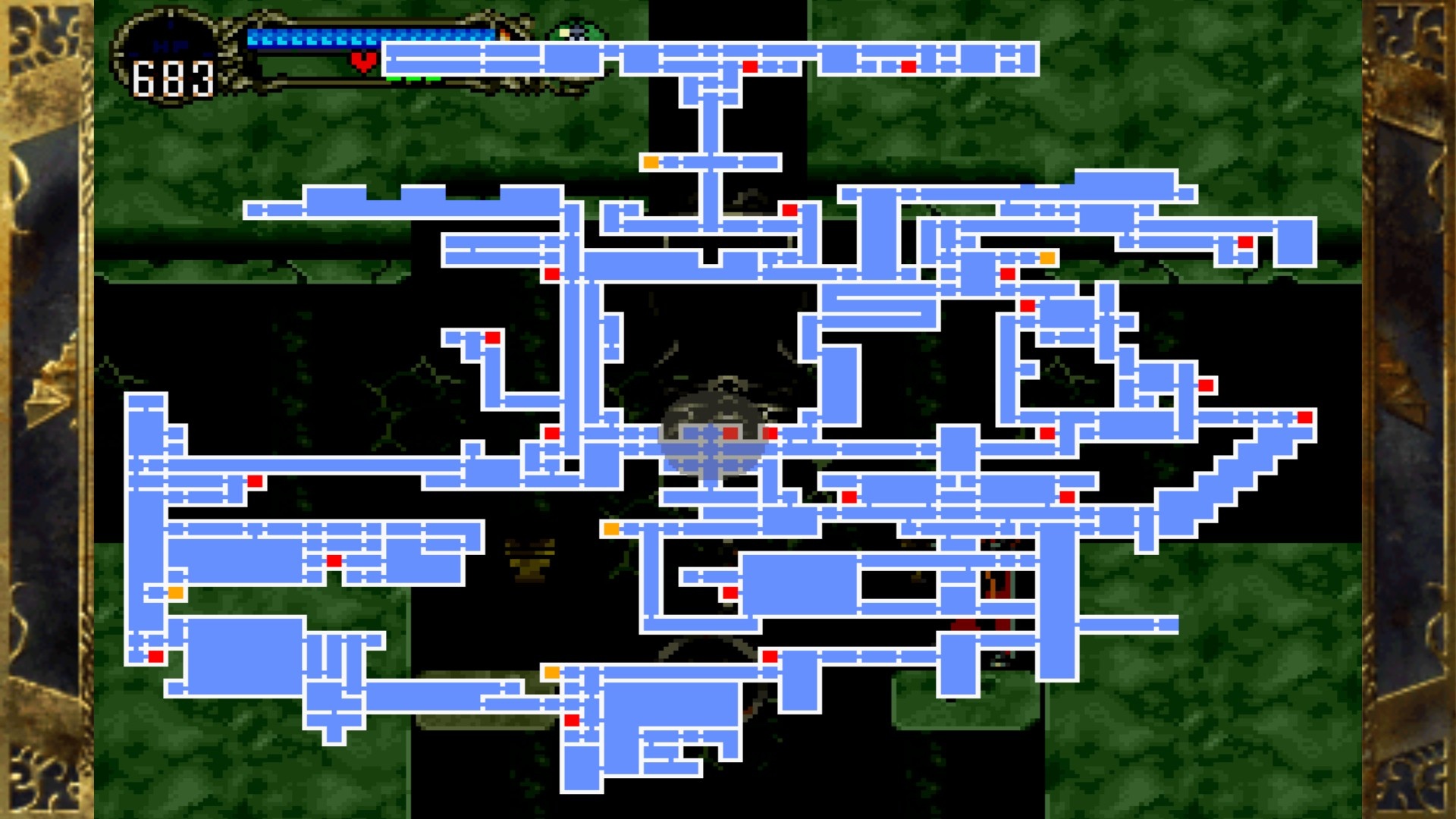
Некоторые места не заносятся в карту по каким-то причинам?
Итоги:
Castlevania: Symphony of the Night действительно одна из лучших игр серии. Но является ли самой лучшей и является ли шедевром? С точки зрения сложности Symphony сильно проигрывает предыдущим играм серии, но в плане разнообразия она явно обыгрывает большинство тогдашних игр (да и некоторые современные). Но у игры по современным меркам слабый сюжет и отсутствие сложности в первой половине игры. А является ли шедевром? С точки зрения внутриигровых возможностей и атмосферы Symphony of the Night безусловно шедевр. Даже следующие игры серии не смогли с ней конкурировать(по ряду технических и не только причин). Неудивительно, что игра стала вдохновением для многих игр от крупных AAA до инди. Я очень часто ищу игры, которые бы была похожи на Symphony в этом плане. И пока среди крупных проектов мне приглянулась серии игр Souls и Ведьмак, а среди инди игр Unepic, La-Mulana и Dust: An Elysian Tail.
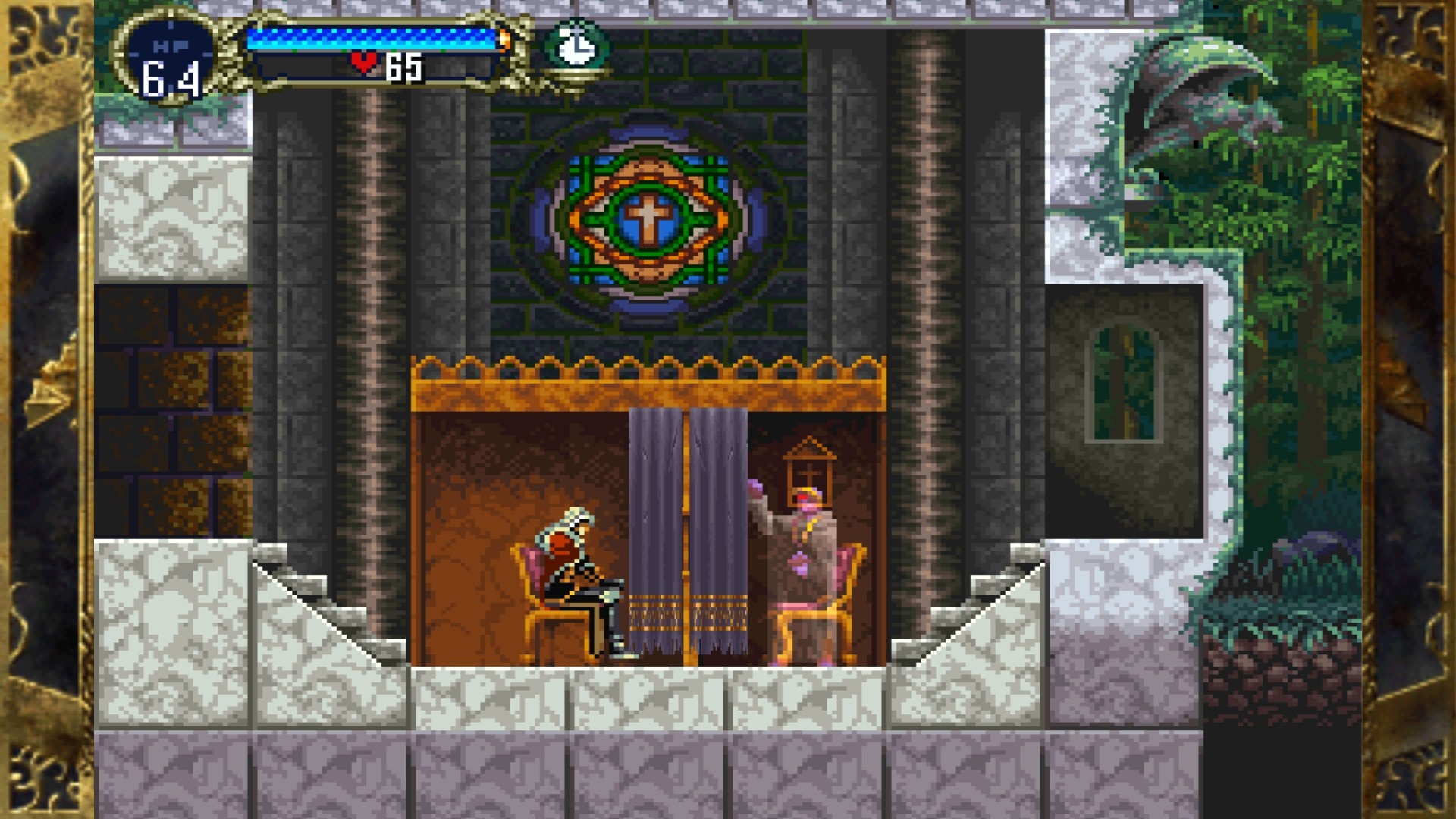
Исповедаться никогда не поздно, но осторожность не помешает даже в этом деле!
Contents
Game specific information
Castlevania: Symphony of the Night
Alucard can summon five Familiars by locating card relics scattered throughout the game's two castles. Only one of these may be active at any time during gameplay. They include:
Demon Familiar The Demon Card can be found in the Abandoned Pit to the Catacomb. The player will find a switch in a wall that cannot be hit. The Demon Card can be found by going one room down and one room to the left. Faerie Familiar The Faerie Card can be found in the Long Library. It is located at the top left door of the largest room. This room can be reached by changing into a bat or by jump kicking off of Spellbooks after acquiring the Leap Stone. Ghost Familiar The Ghost Card is in the very top of the Castle Keep at the top of the map. It is at the top of the broken staircase, along with some other useful items. Bat Familiar The Bat Card can be found in the room where Slogra and Gaibon were fought at the beginning of the game. It is in the upper right corner of the room and can be reached either by using Form of Bat or by double high jumping to reach it. Sword Familiar The Sword Card can be found in Olrox's Quarters. Take the lower left door in the large room with the fountain. In this hallway, that leads to the Royal Chapel, find the breakable ceiling and go up.
In the Japanese and The Dracula X Chronicles versions, there's also a Nose Demon Familiar and a Fairy Familiar, in addition to the pre-existent Familiar types.
Castlevania: Circle of the Moon
Nathan Graves can summon familiars by combining the Saturn Action Card with an Attribute Card as per the Dual Set-Up System. Each of the ten possible combinations will summon a different familiar.
Castlevania: Aria of Sorrow
Castlevania: Dawn of Sorrow
Soma Cruz can summon familiars after absorbing certain enemies' souls. All of them are Guardian Souls.
Castlevania: Curse of Darkness
Creatures that aid Hector in Curse of Darkness are not called "familiars" but instead Innocent Devils.
Castlevania: Order of Ecclesia

Shanoa may summon the aid of some creatures by equipping certain glyphs on her back. These familiars vary greatly in speed, attack power, aggressiveness, and may even inflict status ailments to enemies, such as Poison or Stone.
Each familiar can be leveled-up twice by absorbing more glyphs of the same familiar type. They can also level up by letting them kill enemies, although this process is much slower.
They reach Level 2 at 32,767 XP and max out at 65,535 XP, which is Level 3 (the message "LEVEL UP" will appear onscreen when a new level has been reached). Unfortunately, there's no in-game way of checking how much experience a familiar has gained. They gain 3 XP for hitting an enemy and they gain 2,000 XP when Shanoa absorbs another copy of their own glyph.
So, according to this math, it takes 17 copies (rounded up from 16.38 and not taking into account enemies hit/killed by the familiar itself) of the glyph to grow one level. If the familiar is onscreen at the moment it gains a level, it will not immediately display its new abilities; it must first be sent away and summoned again.
Familiars have a base ATK that is affected by Shanoa's own STR or INT at the time of summoning. They are also affected by Shanoa's Attribute Points. However, the familiar's ATK will not be affected by any changes after it is summoned. A good strategy to benefit from this behavior is by boosting Shanoa's own specific stats corresponding to those of the familiar that will be summoned, no matter the cost to other stats. After the familiar has been summoned, the player may then switch to any other apparel they want, while the familiar will keep its enhanced stats for the duration of the summon.
Castlevania: Harmony of Despair
Soma Cruz is the only character able to utilize familiars in Harmony of Despair. He has a wide variety of familiars, including several "Retro" familiars to this game.
Sword Familiars in Castlevania
Castlevania: Symphony of the Night introduced the Sword Familiar. In addition to randomly slicing enemies on the screen, it had a personality: could talk, could level up and gain new abilities, including the ability to be used as a regular sword. Soma Cruz can summon a similar familiar called the Alastor Familiar in Aria of Sorrow and Dawn of Sorrow by obtaining and using Alastor's soul.
Читайте также:

